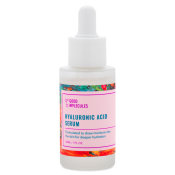
If you’ve been following along with our Serum Series, you already know what serums are and which ones would be most effective for your unique skin concerns. Now let’s get to the good stuff: how and when to use them.
Where do serums fit in my existing skincare routine?
Basically, after cleansing (or after your toner if you use one), before moisturizing. But be sure not to dry your face completely after cleansing as your skin will absorb serums best when moist. The moisture helps the active ingredients penetrate deeper into the skin. This is a common mistake that even the best of us have made, myself included (oops!).
 Do I still need to moisturize after applying serums?
Do I still need to moisturize after applying serums?
Yes! Even if you apply a super hydrating serum packed with hyaluronic acid (which helps skin retain moisture), you still need a lotion or cream—depending on your preference of richness—to create a barrier on top of skin. This will lock all the good stuff in and protect against the bad. Don’t forget to follow with sunscreen!
Can I combine multiple serums?
Of course. While there isn’t a hard rule, we recommend layering no more than three serums at a time. This ensures that your skin is fully absorbing each product, and you’re getting the most out of it. Also, make sure to give each serum at least a minute or two before moving on to the next. Pro tip: Apply serums by their consistency, with the lightest serum first. If they’re similar consistency, start with the serum with the benefits that are most important to you.
Which serums don’t work well together?
Try to avoid combining serums with potentially drying ingredients, such as alpha hydroxy acids or retinoids, as they could be too harsh and irritate skin. If you want to incorporate more than one of these, split them up between your morning and nighttime routine to get the most out of each one separately.
Morning or night?
That depends on the serum. Some are specifically formulated to leave on the skin overnight, like Good Molecules Overnight Exfoliating Treatment. Overnight serums usually repair and renew the skin and work best at night when the skin is naturally recharging and regenerating cells. However, most serums are suitable for morning and/or night, once or twice a day, like Herbivore Cloud Jelly Plumping Hydration Serum or Peter Thomas Roth FIRMx Collagen Serum.
How long are serums good for?
Since serums are packed with active ingredients, they can oxidize and become less effective over time. Store them in a cool, dry place, and they should be good to use for anywhere between six months to a year, depending on the serum and its ingredients. Vitamin C, for example, is notorious for losing efficacy and potency pretty quickly, while some retinol serums can last up to nine months. Be sure to read the label to tell how to store it and when to throw it out.
Lastly, remember that consistency is key! Stick with your serum(s), and apply consistently for at least a month for your skin to reveal visible, lasting results. Trust us, they’re worth an additional step in your usual routine.
Illustrations by Megan Badilla
Featured Products
You Might Also Like
-

Self-Tanners
How to Remove a Fake Spray Tan
- 407
-

Sun Protection
Chocolate Is The New Tan
- 43
-

Skincare
Are You Skipping This Necessary Skin Care Step?
- 1018
-

Skincare
DIY Blueberry Skin Care Recipes
- 719
-

Face Skincare
Top 6 Skincare Remedies for Hormonal Acne
- 431
-

Toners & Mists
Should You Use a Toner?
- 174











